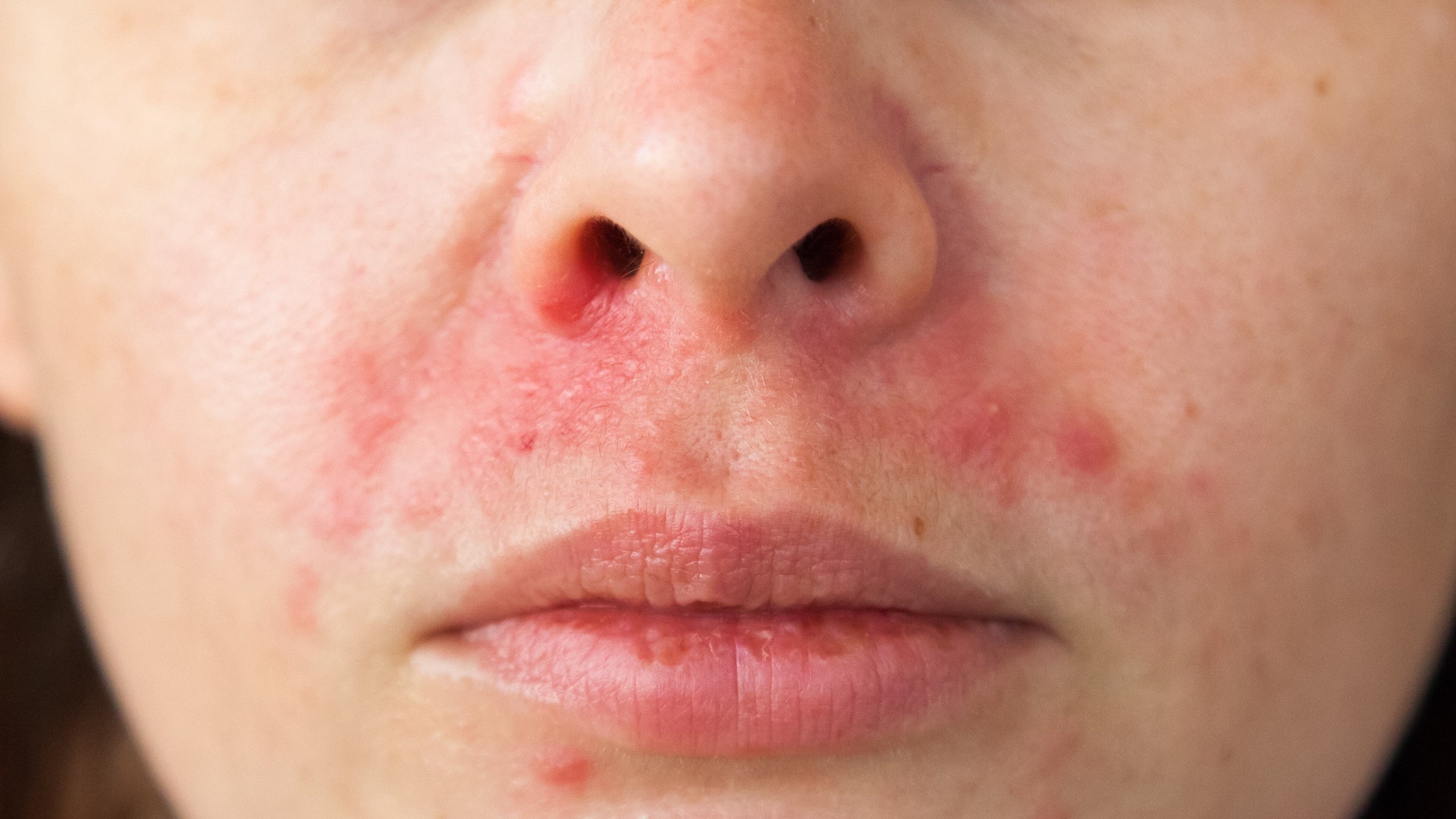Dermatitis isn’t a one-size-fits-all diagnosis. The term “dermatitis” is a general word used to describe skin inflammation. Typically, dermatitis appears as rashes, dry skin, itchiness, swelling, and blisters. It can occur on your face, feet, hands, and anywhere in between. Causes, symptoms, and treatments can differ depending on which type of dermatitis you have.
Here’s what you need to know about the 9 types of dermatitis. For a proper diagnosis, always consult with a board-certified dermatologist or your primary health care provider.
The 9 Types of Dermatitis
Atopic Dermatitis
Atopic dermatitis is the most common form of eczema. It causes itchy, scaly, dry skin. The skin condition typically begins in childhood and remains chronic throughout a person’s lifetime. It’s most often found in the creases of your elbows or knees, though it can occur anywhere on the body. People with atopic dermatitis often have an overgrowth of flare-causing bacteria on their skin microbiome and can benefit from microbiome-balancing products like Gladskin Eczema Cream.
Dyshidrotic Eczema
Dyshidrotic eczema, also known as pompholyx, foot-and-hand eczema, palmoplantar eczema, or vesicular eczema, is a form of eczema that causes small, itchy, water-filled blisters on the hands and feet. As blisters dry out, the skin can become cracked, red, and dry. Dyshidrotic eczema can be triggered by sweat, stress, and irritants like cobalt, nickel, soaps, and shampoos. Treatments include moisturizing to repair the skin barrier, UV therapy, and prescription topicals.
Occupational Dermatitis
Occupational dermatitis is a form of contact dermatitis that occurs when you come into contact with irritants in the workplace. If you’re a chef, metaworker, manufacturer, custodian, healthcare worker, farmer, construction worker, hairdresser, or work in any other profession where your hands get wet or are exposed to chemicals regularly, then you’re at particular risk of developing occupational dermatitis. Identifying workplace triggers, wearing nitrile-free gloves to protect your hands while working, and patch testing to determine any occupational allergies are all strategies to help manage occupational dermatitis.
Perioral Dermatitis
Perioral dermatitis is defined as inflammation around the mouth. It causes a rash and may be flaky or bumpy. Perioral dermatitis is most common in women ages 20-40 and can be triggered by prolonged use of topical or inhaled steroids and heavy cosmetics, moisturizers, and sunscreens. Discontinuing use of triggering products can help address perioral dermatitis. Doctors may also prescribe anti-inflammatory creams or topical or oral antibiotics.
Seborrheic Dermatitis
Seborrheic dermatitis occurs when an overgrowth of Malassezia yeast on the skin triggers the immune system to overreact, creating an inflammatory response. It causes scaly, crusty, red patches of skin on the face, nose, eyebrows, ears, eyelids, armpits, and scalp. In infants, it’s known as cradle cap. Dandruff is caused by seborrheic dermatitis. Seborrheic dermatitis is often treated with antifungal creams and shampoos. In more severe cases, doctors may prescribe calcineurin inhibitors or antifungal pills.
Stasis Dermatitis
Stasis dermatitis is a form of eczema resulting from poor circulation in the lower legs. It occurs when valves in the veins weaken and leak fluid. This causes water and blood cells to pool in the legs. Stasis dermatitis is also sometimes called gravitational dermatitis, venous eczema, or venous stasis dermatitis. In addition to treating the skin, providers will also suggest treatments for improving blood flow and reducing swelling , such as wearing compression stockings and elevating the legs above the heart.
Diagnosing Dermatitis
Most often, a health care provider will diagnose dermatitis based on a physical examination of the skin and overview of your medical history. If you or the provider suspects your dermatitis may be in response to an allergen, they’ll perform a skin patch test. If the type of dermatitis isn’t obvious to the naked eye, your provider may perform a skin biopsy, which involves removing a small sample of the skin for laboratory analysis and testing.
Dermatitis Treatment Options
Each type of dermatitis comes with a unique treatment plan. That’s why it’s important to consult with a healthcare professional to help clear up your skin.
Depending on the form of dermatitis you’re experiencing, your provider may recommend:
- Creams or lotions
- Topical steroids
- Antihistamines to reduce itchiness
- Phototherapy
- Avoiding triggers through diet and lifestyle changes
To help improve the overall health of your skin no matter what form of dermatitis you’re experiencing, you can:
- Use moisturizer. Apply it right after you shower or bathe to lock the water into the skin.
- Avoid overheating. Staying cool helps avoid rash flare-ups and prevent itchiness.
- Use lukewarm water. Skip a hot shower in favor of a lukewarm one to help prevent irritating the skin.
- Choose a mild cleanser. Skin harsh soaps full of fragrances and preservatives. Instead, use a gentle, hypoallergenic body wash.
-
Balance your skin microbiome. Bacterial overgrowth plays a role in many types of dermatitis. Gladskin Eczema Cream with Micreobalance® creates a healthy environment for good bacteria on your skin to thrive.

Moving Forward With Dermatitis
Although dermatitis is common and normal, it can impact your quality of life. Seeking medical help and determining the appropriate treatment, no matter what type of dermatitis you have, can help you feel comfortable in your skin.
